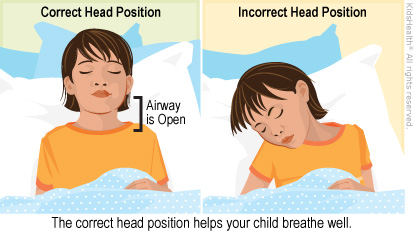After Procedural Sedation: How to Care for Your Child
After your child has a procedure, recovery from sedation can take several hours, depending on the type of sedative used.


Your child received sedation to manage anxiety or pain or to control movement during a procedure. Your child may feel sleepy or irritable or have trouble with head control and balance. Your child also may feel nauseated during recovery. It's important to know how to position your child's airway to keep it clear.

-
If your child is sleepy or nauseated, keep your child in a position that keeps the airway clear, as instructed by your health care provider.
-
Your child should not crawl, walk, or perform activities requiring balance and coordination until fully awake and balance has returned to normal. Your child might need help in the bathroom during recovery.
-
Keep your child hydrated with clear liquids. The best choice is an oral electrolyte solution (which can be found in any drugstore or grocery store), sports drink, or flat soda. Babies who are breastfed can continue on breast milk.
-
Your child's first meal should be light and easy to eat. If your child keeps the food down, you can resume serving a normal diet.
-
Your child may return to normal activities the next day.
-
Do not allow your older teen to drive, operate heavy machinery, or drink alcohol for 24 hours.

-
Your child is very sleepy.
-
Your child becomes extremely agitated.
-
Your child has fever or pain. (While not likely to be related to the sedation, it could be a cause for concern.)
-
You do not hear from your health care provider about your child's test results within a week.

Your child:
-
Has breathing problems, such as unusual snoring, wheezing, or working hard to breathe.
-
Is difficult to wake up.
-
Vomits more than 4–5 times over 3–4 hours.
-
Has vomiting that is bright green (bile) or yellow.
-
Appears to be dehydrated; signs include dizziness, drowsiness, a dry or sticky mouth, sunken eyes, producing less urine or darker than usual urine, crying with little or no tears.